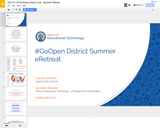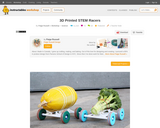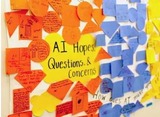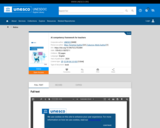
Free PowerPoint Click and Reveal Interactions
- Subject:
- Educational Technology
- Material Type:
- Interactive
- Author:
- Tony Vinckx
- Date Added:
- 03/02/2024

Free PowerPoint Click and Reveal Interactions

This is a collection of suggested learning objectives, instructional resources, and "teachable moments" that can be used as the starting point for constructing a K-12 scope & sequence for Media Literacy & Digital Citizenship skills, as well as some Research skills. Or it can just be used to find lesson plans, etc., for teaching specific topics.

Includes two interactive slide decks that provide overviews of some of the most useful collections of instructional resources, one for grades K-5, the other for grades 6-12. There are many more resource collections out there: these are just the "greatest hits"! Also includes collections of questions that can be used to engage students in Media Literacy.

This slide deck provides a brief introduction to the subject areas of Media Literacy and Digital Citizenship, as well as links to organizations it's good to know about.

Open Educational Resources presentation

23 Things is a suite of 23 self-paced online modules that cover a range of topics from video editing to basic coding. Each module or 'thing' consists of information, interactive activities, and invitations to try out various open and free software applications and technologies. The modules have been created using H5P and can be downloaded individually as a single H5P file, modified and re-used under a CC-BY-SA licence - simply click on the 'reuse' link at the bottom of each module.
The content was created by Curtin University students as part of a 'students as partners' project.

Create 3D printed components for a vegetable/fruit STEM racer!
From the article:
"These 3D printed STEM race cars are the perfect project based learning tool to help teachers get kids excited about science, technology, engineering, math, and nutrition to boot! The racers I show you how to make in this instructable will provide an opportunity to turn almost anything (no kittens or other live things please) into a race car – allowing different sized and weighted objects to illustrate mechanical physics concepts like mass, friction, force, speed, distance, and gravity!"

This is a short lesson plan for discussing/reviewing order of operations with technology integration.

This is an extension activity after discussing cancer or lead into discussing about student choices. Essential QuestionsStudents will be able to to describe behaviors lead to skin cancer and how can it be prevented.Students will be able to explain the risk and reward behaviors.

This is a short description of the ACAT Method.The method uses analogous comparisons by taking examples or situations from everyday life and in consequence the logical or analogous transfer to the scientific problem. The method uses the development of imaginations or “pictures in the head” to develop a view of the analogy; this picture is transferred as a problem-solving idea to the concrete scientific problem. Multimedia material like animations are used to provide a higher level of imagination and to develop the understanding for the discussed problem.

ADDIE - Instructional Design Template.

Add the General description for teachers to see. And resource added in the "Add Resource" will be for the teacher only.

Affective Assessment is an assessment based on the student's attitudes, interest and values. Affective Domain .The Affective Taxonomy, which describes objectives that reflects underlying emotions, feelings, or values rather than cognitive or thought complexity

AFFECTIVE-BASED AUTHENTIC ASSESSMENT -The affective domain includes factors such as student motivation, attitudes, perceptions and values. Teachers can increase their effectiveness by considering the affective domain in planning courses, delivering lectures and activities, and assessing student learning

This image describes the basic character of Artificial Intelligence

Welcome to The AI Challenge, a self-paced Design Forward module created to build faculty capacity with generative artificial intelligence (GENAI). In each topic page you will find related resources, questions, and activities.
Since this is a self-paced module, you should proceed in whatever way makes you comfortable. Feel free to take as little or as much time as necessary and focus on whatever components resonate most deeply with you and your own pedagogical value and needs.
We look forward to seeing you around the module!

The arrival of artificial intelligence has sent shockwaves through numerous industires. Instructional design and education, like many other fields, are bracing for impact. The conversation around AI in instructional design and education has ranged from doomsday scenarios to claims of a new savior. The only constraint in these projects is a general lack of data supporting either scenario. To inform our strategy plan for the utilization and adoption of AI tools, the AI working group at Emeritus Institute of Management conducted a pilot study, assaying the impacts of two tools, ChatGPT and Blue Willow, on the efficiency and effectiveness of these tools in completing common design tasks. This paper describes our study design and the results of our experiment.

This resource includes a set of activities, teacher guides, assessments, materials, and more to assist educators in teaching about the ethics of artificial intelligence. These activities were developed at the MIT Media Lab to meet a growing need for children to understand artificial intelligence, its impact on society, and how they might shape the future of AI.
This curriculum was designed and tested for middle school students (approximately grades 5th-8th). Most activities are unplugged and only require the materials included in this document, although unplugged modifications are suggested for the activities which require computer access.

AI processes vast information, generates new content, and helps decision-making through predictive analyses. In education, AI has transformed the traditional teacher–student relationship into a teacher–AI–student dynamic.
This shift requires a re-examination of teachers’ roles and the competencies they need in the AI era. Yet, few countries have defined these competencies or developed national programmes to train teachers in AI, leaving many educators without proper guidance.
The AI competency framework for teachers addresses this gap by defining the knowledge, skills, and values teachers must master in the age of AI. Developed with principles of protecting teachers’ rights, enhancing human agency, and promoting sustainability, the publication outlines 15 competencies across five dimensions: Human-centred mindset, Ethics of AI, AI foundations and applications, AI pedagogy, and AI for professional learning. These competencies are categorized into three progression levels: Acquire, Deepen, and Create.
As a global reference, this tool guides the development of national AI competency frameworks, informs teacher training programmes, and helps in designing assessment parameters. It also provides strategies for teachers to build AI knowledge, apply ethical principles, and support their professional growth.

Computer science is about so much more than coding! Learn about AI, machine learning, training data, and bias, while exploring ethical issues and how AI can be used to address world problems.